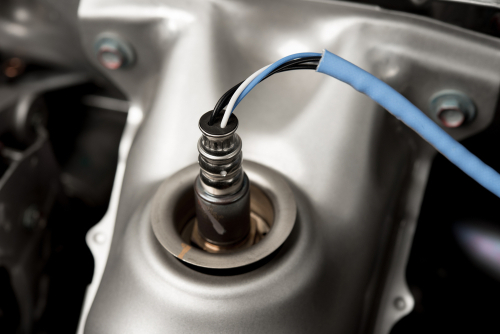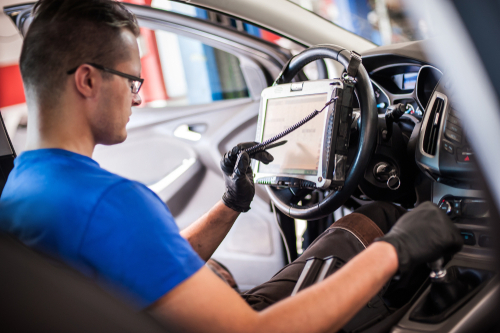Is your check engine light on? You might be dealing with the P0037 code. This pesky diagnostic trouble code indicates a problem with the heated oxygen sensor heater control circuit on Bank 1, Sensor 2 of your engine.
Don’t worry, it’s not as complicated as it sounds!

The P0037 code typically means there’s an issue with the heating element of the downstream oxygen sensor located behind your catalytic converter. This little gadget plays a big role in your car’s emissions system, helping to keep your ride running clean and efficient.
When it’s not working properly, your engine performance can take a hit.
You might be wondering what causes this code to pop up. Well, it could be a faulty O2 sensor, wiring problems, or even issues with your car’s computer.
But don’t fret! With a bit of know-how and some elbow grease, you can tackle this problem and get your trusty steed back in top form.
Key Takeaways
- The P0037 code indicates a problem with the oxygen sensor’s heating element
- Common causes include faulty sensors, wiring issues, or computer malfunctions
- Proper diagnosis and repair can restore engine performance and emissions control
Unraveling the Mystery of Code P0037
When your car’s check engine light comes on, it’s like a game of automotive Clue. Let’s solve the mystery of P0037 together and figure out whodunit in your engine bay.
Decoding the Jargon
P0037 might sound like a secret agent code, but it’s actually a diagnostic trouble code that’s trying to tell you something important. HO2S stands for Heated Oxygen Sensor – your car’s very own air quality detective.
This little gizmo sniffs out the oxygen in your exhaust to help your engine run efficiently.
The “heater control” part is like a tiny furnace for your sensor. It keeps things toasty so the sensor can do its job properly, even when it’s chilly outside.
When your car says “circuit low,” it’s complaining that this heater isn’t getting enough juice to warm up.
The Culprit – Bank 1 Sensor 2
Now, let’s pinpoint the troublemaker. Bank 1 refers to the side of your engine with cylinder number one. It’s like the VIP section of your engine block.
Sensor 2 is the downstream oxygen sensor, hanging out behind the catalytic converter.
This sensor is the second in line, keeping an eye on how well your catalytic converter is doing its job. When it’s not heating up properly, it can’t give accurate readings.
This can lead to poor fuel economy, higher emissions, and even damage to your catalytic converter if left unchecked.
Common Causes of the HO2S Heater Control Circuit Low

You’ve got a P0037 code, and now your car’s acting like it’s got a bad case of the sniffles. Let’s dive into the common culprits behind this pesky problem.
From wiring woes to sensor snafus, we’ll uncover what’s making your HO2S heater control circuit feel a bit under the weather.
Wiring Woes
You know how you feel when your sweater gets snagged on a nail? Well, your car’s wiring can suffer similar misfortunes. Damaged wiring is often the prime suspect in HO2S heater control circuit issues.
Think of your wiring harness as the nervous system of your car. When it gets pinched, frayed, or corroded, it’s like a bad case of automotive carpal tunnel.
Check for:
- Exposed wires (ouch!)
- Melted insulation (too hot to handle)
- Loose connections (nobody likes a flaky friend)
Don’t forget to give the connectors a once-over. They can get grumpy with age and start resisting their job, kind of like your old Uncle Bob at family gatherings.
Fuse Frustrations
Ah, the humble fuse. It’s like the bouncer of the electrical world, keeping things from getting too wild at the party. But sometimes, it takes its job a bit too seriously and shuts everything down.
A blown fuse can leave your HO2S heater control circuit feeling rather chilly. Here’s what you should do:
- Locate the fuse box (it’s not playing hide and seek, promise)
- Find the right fuse (consult your manual, it’s not cheating)
- Check for signs of a blown fuse (look for that telltale dark spot)
If you find a blown fuse, don’t just pop in a new one and call it a day. It might be trying to tell you something’s amiss downstream.
Sensing Sensor Snags
Your oxygen sensor is like a health monitor for your exhaust. But when it’s feeling under the weather, it can throw a wrench in the whole operation.
A faulty sensor can cause all sorts of mischief. Here’s what to look out for:
- Sluggish warm-up times (like trying to wake a teenager)
- Erratic readings (it’s not supposed to play guessing games)
- Physical damage (dents and dings are for golf balls, not sensors)
Remember, your sensor’s heating element is crucial. If it’s not warming up properly, your engine management system might think it’s stuck in an eternal winter.
Diagnostic Drills for the Daring Driver

Ready to roll up your sleeves and get your hands dirty? These diagnostic techniques will help you pinpoint that pesky P0037 code issue.
Just remember, safety first – no shocking yourself or setting anything on fire!
Visual Inspection Ventures
Start your detective work with a good old-fashioned visual inspection. Pop the hood and locate Bank 1 Sensor 2 – it’s usually downstream of the catalytic converter.
Check for any obvious damage to the sensor or wiring.
Look for frayed wires, loose connections, or corrosion. Sometimes, a simple loose connection can trigger that annoying check engine light.
Don’t forget to inspect the connector pins – they should be clean and free of debris.
If everything looks ship-shape, give the wiring harness a gentle wiggle. You might just uncover an intermittent connection issue that’s been driving you nuts.
Multimeter Mastery
Time to channel your inner electrician! Grab your trusty multimeter and let’s check the heater control circuit.
First, test the voltage feed from the ECM to the sensor. You should see battery voltage when the key is on.
No voltage? You might have a wiring issue or a faulty ECM.
Next, perform a resistance test on the heater element. Disconnect the sensor and measure across the heater pins.
You’re looking for a reading between 5-15 ohms. If it’s out of range, your sensor might be toast.
Don’t forget to check for continuity in the wiring between the sensor and the ECM. No continuity means a broken wire – time for some automotive surgery!
Sensor Simulation
Ready to play pretend? It’s time to simulate a working sensor and see how your engine reacts. You’ll need an OBD-II scanner with live data capabilities for this one.
Start by unplugging the sensor and connecting a known good sensor in its place.
Clear the codes and take your car for a spin. If the P0037 code doesn’t come back, you’ve likely found your culprit.
No spare sensor? Try jumpering the heater circuit pins at the ECM. If the code clears, you know the issue lies somewhere between the ECM and the sensor.
Remember, these tests can get tricky. If you’re not comfortable playing with live circuits, it’s always best to leave it to the pros.
No shame in admitting defeat – that’s what mechanics are for!
Navigating the Repair Route
Fixing the P0037 code can be a bit tricky. You’ll need to decide whether to tackle it yourself or seek professional help. Plus, you’ll want to keep an eye on those repair costs – they can sneak up on you faster than a cat on a mouse!
Professional Mechanic or DIY
Thinking about getting your hands dirty? Well, before you dive in, consider this: diagnosing and fixing P0037 can be like trying to find a needle in a haystack.
If you’re not comfortable with electrical systems, it might be best to leave it to the pros.
A certified technician has the tools and know-how to pinpoint the issue quickly. They can test the oxygen sensor’s heating element and check for any wiring problems.
Plus, they won’t accidentally fry your car’s computer – always a bonus!
But if you’re feeling brave and have some mechanical skills, you could give it a shot. Just remember, YouTube tutorials are your friend!
Cost Considerations
Now, let’s talk money – everyone’s favorite topic, right?
The cost to fix P0037 can vary more than the weather in spring. If you’re going the DIY route, you might save some cash, but remember to factor in the cost of tools and parts.
For professional repairs, labor rates can range from “ouch” to “holy smokes!” Auto repair shops typically charge between $80 to $150 per hour.
The total bill could look something like this:
- Diagnostic fee: $50-$100
- Oxygen sensor replacement: $200-$300
- Labor: $100-$200
Of course, these are ballpark figures. Your actual costs might be higher or lower, depending on your vehicle’s make and model. Just don’t be surprised if your wallet feels a bit lighter afterward!
Ensuring a Healthy Drive Post-Repair

After fixing that pesky P0037 code, you’ll want to make sure your ride stays in tip-top shape.
Let’s look at how to keep your engine purring and your wallet happy.
The Aftermath of the Fix
You’ve just tackled the HO2S heater issue, and now it’s time to reap the rewards.
Your downstream oxygen sensor is back in action, keeping a watchful eye on your exhaust.
Keep your ears perked for any unusual sounds. A smooth-running engine is a happy engine.
Watch your fuel gauge too – you might notice a pleasant surprise at the pump.
If you were failing emissions tests before, give yourself a pat on the back. You’ve likely just become a better Earth citizen. Your catalytic converter will thank you for the assist.
Maximizing Mileage and Efficiency
Now that your O2 sensor is doing its job, let’s talk about squeezing every mile out of that tank.
Your fuel efficiency should be on the up and up.
Keep those tires properly inflated – it’s like giving your car comfy slippers.
A clean air filter is your engine’s best friend. It’s like letting it breathe mountain air instead of city smog.
Take it easy on the gas pedal. Pretend there’s an egg between your foot and the pedal – your wallet will thank you.
And remember, a well-maintained exhaust system is key to keeping that P0037 code at bay. Think of it as your car’s version of eating its veggies.
Frequently Asked Questions
The P0037 code can be tricky to diagnose and fix. Let’s tackle some common questions to help you understand this pesky problem and get your ride running smoothly again.
What are the common symptoms of a P0037 code in a vehicle?
You might notice your check engine light illuminating like a Christmas tree.
Your car could also start sounding rougher than your grandmother’s voice after a night of karaoke.
Poor fuel economy is another telltale sign. If you’re suddenly best buddies with the gas station attendant, it might be time to check for this code.
How can I locate the HO2S bank 1 sensor 2 in my car?
Finding this sensor is like playing automotive hide-and-seek.
It’s usually downstream of the catalytic converter on the side of the engine with cylinder number one.
Your trusty service manual is your treasure map here. When in doubt, pop the hood and look for labels – they’re your automotive breadcrumbs.
Is it safe to drive my vehicle with a P0037 error code?
Driving with this code is like walking on thin ice – you might be okay for a bit, but it’s not a great long-term plan.
Your engine could be running inefficiently, guzzling gas like it’s going out of style.
It’s best to get it checked out sooner rather than later. Your wallet (and the environment) will thank you.
What steps should I take to fix the P0037 code?
First, channel your inner detective and inspect the wiring connected to the sensor. Look for any signs of damage or corrosion.
Next, test the sensor’s heating element. If it’s kaput, you’ll need to replace the sensor.
Remember, a little elbow grease now can save you a big headache later.
Could you explain the potential causes for the P0037 code to appear?
This code could pop up due to a few culprits. A faulty oxygen sensor is often the main suspect in this automotive whodunit.
Other potential troublemakers include damaged wiring, a blown fuse, or issues with the heater control circuit. Sometimes, it’s even the PCM playing tricks on you.
What is the difference between the HO2S bank 1 sensor 2 and bank 1 sensor 1?
Think of these sensors as upstream and downstream neighbors.
Sensor 1 lives before the catalytic converter, while Sensor 2 is its downstream buddy.
Sensor 1 helps adjust the air-fuel mixture, while Sensor 2 keeps an eye on how well the catalytic converter is doing its job.
They’re like the dynamic duo of exhaust management.
